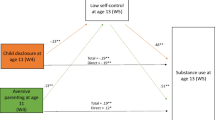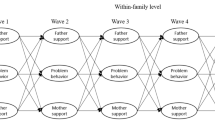Abstract
Past research has generated inconsistent findings regarding the relation of parental control and support to adolescent problem behaviors. Using two waves of data collected 1 year apart, the current study examined the influence of parental control and support on adolescents' externalizing symptoms, alcohol use, and illicit substance use. A sample of adolescents and their parents (@#@ N =454) was studied, within which approximately half of the adolescents were at high risk because of parental alcoholism. Multipleregression analyses of crosssectional data showed a negative quadratic relation between parental control and adolescent externalizing symptomatology, and between parental control and adolescent illicit substance use. Parental control had a negative linear relation to adolescent alcohol use. Parental support showed a negative quadratic relation to adolescent illicit substance use, and negative linear relations to adolescent alcohol use and externalizing symptoms. Although longitudinally adjusted contemporaneous results were consistent with crosssectional findings, parental support and control were prospectively related only to adolescent alcohol use. The quadratic relations suggest that adolescents who receive either extreme of parental support or control are at risk for problem behaviors.
Similar content being viewed by others
References
Achenbach, T., & Edelbrock, C. (1983).Manual for the Child Behavior Checklist and Revised Child Behavior Profile. Burlington: University of Vermont, Department of Psychiatry.
Akers, R. L., Krohn, M. D., Lanza-Kaduce, L., & Radosevich, M. (1979). Social learning and deviant behavior: A specific test of a general theory.American Sociological Review, 44, 636–655.
Barnes, G. M. (1984). Adolescent alcohol abuse and other problem behaviors: Their relationships and common parental influences.Journal of Youth and Adolescence, 13, 329–348.
Barnes, G. M., Farrell, M. P., & Cairns, A. L. (1986). Parental socialization factors and adolescent drinking behaviors.Journal of Marriage and the Family, 48, 27–36.
Barrera, M., Jr. (1986). Distinctions between social support concepts, measures, and models,American Journal of Community Psychology, 14, 413–445.
Baumrind, D. (1991). The influence of parenting style on adolescent competence and substance use.Journal of Early Adolescence, 11, 56–95.
Becker, W. C., Peterson, D. R., Luria, Z., Shoemaker, D. J., & Hellmer (1962). Relations of factors derived from parent-interview ratings to behavior problems of five-year-olds.Child Development, 33, 509–535.
Braucht, G. N., Brakarsh, D., Follingstad, D., & Berry, K. L. (1973). Deviant drug use in adolescence: A review of psychosocial correlates.Psychological Bulletin, 79, 92–106.
Brook, J. S., Whiteman, M., & Gordon, A. (1983). Stages of drug use in adolescence: Personality, peer, and family correlates.Developmental Psychology, 19, 269–277.
Chassin, L., Barrera, M., Bech K., & Kossak-Fuller, J. (1992). Recruiting a community sample of adolescent children of alcoholics: A comparison of three subject sources.Journal of Studies on Alcohol, 53, 316–319.
Chassin, L., Rogosch, F., & Barrera, M. (1991). Substance use and symptomatology among adolescent children of alcoholics.Journal of Abnormal Psychology, 100, 449–463.
Cohen, J., & Cohen, P. (1983).Applied multiple regression/correlation analysis for the behavioral sciences (2nd ed.). Hillsdale, NJ: Erlbaum.
Coyne, J. C., Wortman, C. B., & Lehman, D. R. (1988). The other side of support: Emotional overinvolvement and miscarried helping. In B. Gottlieb (Ed.),Marshaling social support: Formats, processes, and effects (pp. 305–330). Newbury Park, CA: Sage.
Cronbach, L. J., & Furby, L. (1970). How we should measure “change”-or should we?Psychological Bulletin 74, 68–80.
Dishion, T. J., & Loeber, R. (1985). Adolescent marijuana and alcohol use: The role of parents and peers revisited.American Journal of Drug and Alcohol Abuse, 11, 11–25.
Foxcroft, D. R., & Lowe, G. (1991). Adolescent drinking behaviour and family socialization factors: A meta-analysis.Journal of Adolescence, 14, 255–273.
Furman, W., & Buhrmester, D. (1985). Children's perceptions of the personal relations in their social networks.Developmental Psychology, 21, 1016–1024.
Glueck, S., & Glueck, E. T. (1968).Delinquents and non-delinquents in perspective. Cambridge, MA: Harvard University Press.
Gollob, H. F., & Reichardt, C. S. (1987). Taking account of time lags in causal models.Child Development, 58, 80–92.
Hayduk, L. A. (1987).Structural equation modeling with LISREL. Baltimore: Johns Hopkins.
Hirschi, T. (1969).Causes of delinquency. Berkeley: University of California Press.
Jacob, T., & Leonard, K. (1991, November)Family and peer influences in the development of adolescent alcohol abuse. Paper presented at the NIAAA conference, Working Group on the Development of Alcohol-Related Problems in High-Risk Youth: Establishing Linkages Across Biogenetic and Psychosocial Domains, Washington DC.
Kandel, D. B., & Andrews, K. (1987). Processes of adolescent socialization by parents and peers.The International Journal of the Addictions, 22, 319–342.
Kandel, D. B., Kessler, R. C., & Margulies, R. Z. (1978). Antecedents of adolescent initiation into stages of drug use: A developmental analysis. In D. B. Kandel (Ed.),Longitudinal research on drug use (pp. 73–99). Washington, DC: Hemisphere.
Klein, D. M., Jorgensen, S. R., & Miller, B. C. (1978). Research methods and developmental reciprocity in families. In R. M. Lerner & G. B. Spanier (Ed.),Child influences on marital and family interaction: A life-span perspective (pp. 107–135). New York: Academic Press.
Lamborn, S. D., Mounts, N. S., Steinberg, L., & Dornbusch, S. M. (1991). Patterns of competence and adjustment from authoritative, authoritarian, indulgent and neglectful families.Child Development, 62, 1049–1065.
Lytton, H. (1990). Child and parental effects in boys' conduct disorder: A reinterpretation.Developmental Psychology, 26, 683–697.
Maccoby, E. E., & Martin, J. A. (1983). Socialization in the context of the family: Parent-child interaction. In P. H. Mussen & E. M. Hetherington (Eds.),Handbook of child psychology (4th ed.): Vol. iv. Socialization, personality and social development. New York: Wiley.
Margulies, R. Z., Kessler, R. C., & Kandel, D. B. (1977). A longitudinal study of onset of drinking among high-school students.Journal of Studies on Alcohol, 38, 897–912.
McCord, W., McCord, J., & Howard, A. (1961). Familial correlates of aggression in non-delinquent male children.Journal of Abnormal and Social Psychology, 62, 79–93.
Mercer, G., & Kohn, P. (1980). Child-rearing factors, authoritarianism, drug use attitudes, and adolescent drug use: A model.Journal of Genetic Psychology, 136, 159–171.
Minuchin, S. (1974).Family and family therapy. New York: Tavistock.
Monroe, S. M. (1983). Social support and disorder: Toward an untangling of cause and effect.American Journal of Community Psychology, 11, 81–97.
National Institute of Drug Abuse. (1989).Highlights of the 1988 National Household Survey on Drug Abuse, Rockville, MD: National Institute on Drug Abuse.
Pandina, R. J., & Schuele, J. A. (1983). Psychosocial correlates of alcohol and drug use of adolescent students and adolescents in treatment.Journal of Studies on Alcohol, 44, 950–973
Patterson, G. R., DeBaryshe, B. D., & Ramsey, E. (1989). A developmental perspective on antisocial behavior.American Psychologist, 44, 329–335.
Patterson, G. R., & Reid, J. B. (1984). Social interactional processes within the family: The study of the moment-by-moment family transactions in which human social development is imbedded.Journal of Applied Developmental Psychology, 5, 237–262.
Patterson, G. R., & Stouthamer-Loeber, M. (1984). The correlation of family management practices and delinquency.Child Development, 55, 1299–1307.
Pedhazur, E. J. (1982).Multiple regression in behavioral research: Explanation and prediction. San Francisco: Holt, Rinehart and Winston.
Rogosa, D. (1988). Myths about longitudinal research. In K. W., Schaie, R. T. Campbell, W. Meredith, & S. C. Rawlings (Eds.),Methodological issues in aging research (pp. 171–209). New York: Springer.
Rogosa, D. R., & Willett, J. B. (1985). Understanding correlates of change by modeling individual differences in growth.Psychometrika, 50, 203–228.
Rollins, B. C., & Thomas, D. L. (1979). Parental support, power, and control techniques in the socialization of children. In W. R. Burr, R. Hill, F. I. Nye, & I. L. Reiss (Eds.),Contemporary theories about the family (Vol. 1, pp. 317–364). New York: The Free Press.
Schaefer, E. S. (1965). Children's reports of parental behavior: An inventory.Child Development, 36, 413–424.
Sher, K. J., Walitzer, K. S., Wood, P., & Brent, E. E. (1991). Characteristics of children of alcoholics: Putative risk factors, substance use and abuse, and psychopathology.Journal of Abnormal Psychology, 100, 427–448.
Smart, L. S., Chibucos, T. R., and Didier, L. A. (1990). Adolescent substance use and perceived family functioning.Journal of Family Issues, 11, 208–227.
Weissman, M. M., Wickramaratne, P., Warner, V., John, K., Pursoff, B. A., Merikangas, K. R., & Gammon, G. D. (1987). Assessing psychiatric disorders in children.Archives of General Psychiatry, 44, 747–753.
West, D. J., & Farrington, D. P. (1973).Who becomes delinquent? Nw York: Crane, Russak & Co.
Wolchik, S. A., Beals, J., & Sandier, I. N. (1989). Mapping children's support networks: Conceptual and methodological issues. In D. Belle (Ed.),Children's social networks and social supports. New York: Wiley.
Author information
Authors and Affiliations
Additional information
This research was supported by grant DA05227 from the National Institute on Drug Abuse to Laurie Chassin (principal investigator) and Manuel Barrera, Jr. (coprincipal investigator). Parts of the cross-sectional results were presented at the biennial meeting of the Southwestern Society for Research in Child Development, Tempe, Arizona, March 1992. A version of the longitudinal results was presented at the annual convention of the Western Psychological Association, Portland, April–May 1992. The authors thank Heather Shaw, Patrick Curren, and Steven West for their helpful comments regarding this manuscript.
Rights and permissions
About this article
Cite this article
Stice, E., Barrera, M. & Chassin, L. Relation of parental support and control to adolescents' externalizing symptomatology and substance use: A longitudinal examination of curvilinear effects. J Abnorm Child Psychol 21, 609–629 (1993). https://doi.org/10.1007/BF00916446
Revised:
Issue Date:
DOI: https://doi.org/10.1007/BF00916446




